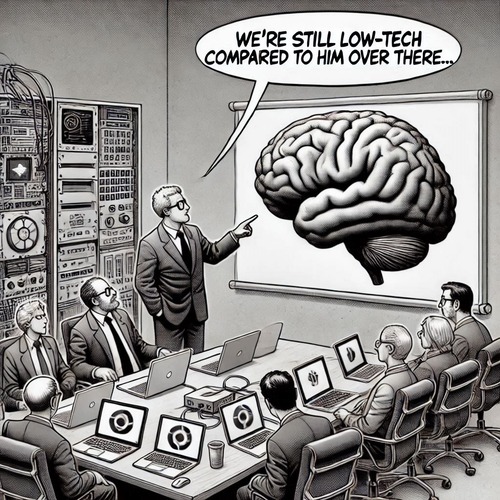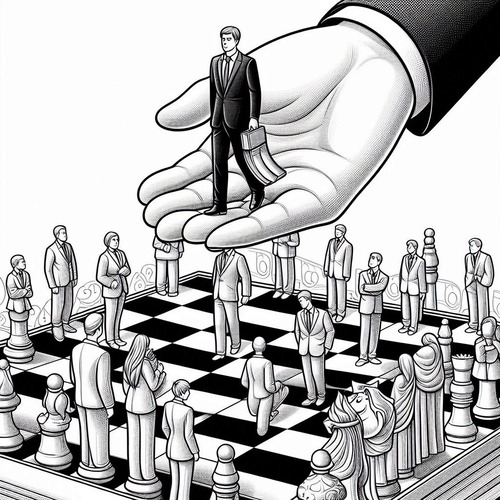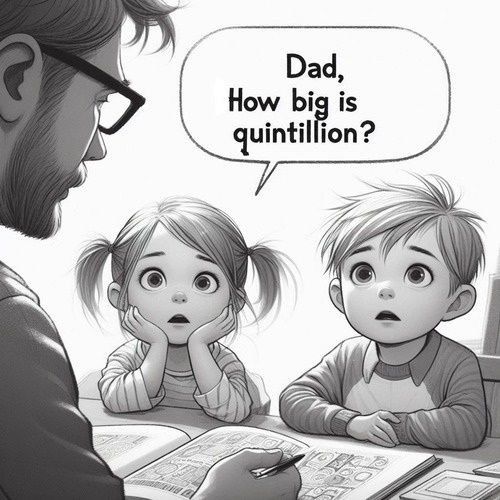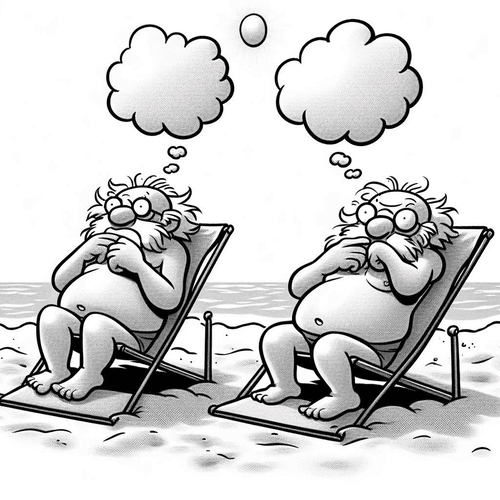Nature’s Ultimate Computer: The Human Brain Defies Evolution
The human brain contains roughly 100 billion neurons forming 100 trillion synaptic connections—a level of complexity that surpasses our most advanced supercomputers. Yet these raw numbers only hint at the true sophistication of what many scientists consider nature’s greatest marvel. As modern neuroscience peels back layers of neural complexity, researchers are confronting an uncomfortable question: Can random evolutionary processes adequately explain the brain’s intricate design?
Architecture To Marvel At
Imagine trying to build a computer that can process sensory input, coordinate movement, regulate bodily functions, store decades of memories, generate consciousness, and repair itself—all while consuming mere watts of power. This is what the human brain accomplishes every moment of every day, through an architectural marvel that increasingly appears to follow sophisticated engineering principles.
Recent research from the Blue Brain Project reveals neural networks organise themselves into multi-dimensional geometric structures that would require precise orchestration of thousands of genes working in concert. The mathematical precision of these structures challenges conventional evolutionary explanations.
Consider just the brain’s basic processing capabilities. A single neuron can make up to 10,000 synaptic connections, with each synapse capable of performing complex computational operations. This massive parallel processing network operates at speeds that make our fastest computers look primitive, yet runs on less power than a light bulb.
Engineering that Defies Current Technology
The brain’s engineering prowess becomes even more apparent when we examine its information processing systems. While artificial neural networks require extensive training to recognise patterns, the human brain naturally processes multiple streams of information simultaneously, integrating sensory data, memories, and emotional content in real-time.
Recent studies in neuroplasticity reveal the brain constantly reconfigures its neural pathways, optimising its architecture for efficiency. This self-optimisation capability goes beyond anything we’ve achieved in artificial systems.
Dr. Thomas Howard of the Neural Engineering Institute notes, “The brain’s ability to rewire itself while maintaining stable function is like trying to rebuild a jet engine while it’s flying.”
The Information Paradox
Perhaps the most significant challenge to evolutionary explanations comes from information theory. The brain’s development requires precisely coordinated genetic instructions that must be present from the beginning. The human genome contains roughly 3 billion base pairs of DNA, but we need additional information to explain how this relatively limited code can generate the brain’s tremendous complexity.
Statistical analyses suggest the probability of random mutations producing even a single optimised neural subsystem falls well below mathematical possibility given the Earth’s presumed age.
Computational biologist, Dr. Sarah Chen explains, “The level of specified complexity we observe in brain development pathways exceeds what unguided processes could reasonably achieve.”
Beyond Random Processes
The brain’s architecture exhibits hallmarks of purposeful design:
- Hierarchical organisation that optimises information flow
- Redundant systems ensuring reliability
- Error-correction mechanisms maintaining stability
- Efficient energy consumption through sophisticated regulation
- Adaptive learning capabilities exceeding current AI
These features mirror principles used in human engineering but implemented with far greater sophistication. The brain achieves this through mechanisms that must work together from the start. Remove any major component, and the system crashes.
Addressing Alternative Explanations
Proponents of traditional evolutionary theory often suggest complex features evolved gradually through natural selection. However, the brain presents unique challenges to this model. Its essential systems—consciousness, memory formation, sensory processing, and autonomous regulation—require numerous interdependent components working in precise coordination.
Comparative neuroscience, while revealing similarities between species, hasn’t adequately explained how incremental changes could produce the quantum leap in complexity observed in the human brain. The fossil record provides no clear pathway for the development of these sophisticated neural systems.
Implications for Scientific Research
Recognising evidence of design in the brain’s architecture doesn’t impede scientific investigation—it enhances it. By approaching the brain as an engineered system, researchers can:
- Better understand its organisational principles
- Identify underlying design patterns
- Develop more effective therapeutic approaches
- Advance neural engineering and AI development
Conclusion
As neuroscience advances, the challenge to explain the brain’s complexity through unguided evolutionary processes grows more acute. The evidence increasingly points to purposeful design—an ultimate engineer implementing sophisticated solutions that continue to surpass human innovation.
The human brain stands as nature’s ultimate computer, exhibiting engineering principles that transcend current technology. Its complexity, efficiency, and elegant design demand an explanation beyond random processes. As we continue to unravel its mysteries, the evidence increasingly suggests that we are, quite literally, fearfully and wonderfully made.
The Human Brain Defies Evolution: Related FAQs
How does the concept of free will fit into the design of the human brain? The design perspective suggests that our ability to make choices isn’t a byproduct of random evolution. Instead, it’s a deliberate feature designed by a Creator to enable humans to have moral responsibility and personal agency. This ability for free will differentiates humans from other creatures and aligns with the idea that we are purposefully created beings.
- Why is the human brain more complex than those of other animals? From a Creationist standpoint, the human brain’s complexity reflects our unique role as beings created in the image of God. This complexity enables us to perform higher-order functions like abstract thinking, creativity, and moral reasoning, which are necessary for fulfilling the purposes assigned to humanity, such as stewardship of the earth and forming relationships.
- How does the concept of consciousness support the idea of intelligent design? Consciousness is one of the most puzzling aspects of the human brain. Creationists argue that such a sophisticated and immaterial phenomenon couldn’t arise from mere physical processes alone. Instead, it points to a higher, intentional creation by an intelligent designer who instilled humans with awareness and self-reflection.
- What role does the brain’s ability to process emotions play in the design argument? Emotions play a crucial role in human experience and relationships, which are central to the Creationist view of human purpose. The ability to experience and process a wide range of emotions is seen as a designed feature, facilitating deep connections with others and with the Creator. This emotional complexity enhances human life beyond mere survival, emphasising a designed purpose.
Are there any brain functions that seem inexplicable by evolution alone? Yes, certain brain functions, like the ability to understand abstract concepts, engage in complex reasoning, and appreciate beauty, seem excessive for survival needs. Creationists argue these functions are best explained by purposeful design, indicating we were created with capacities that exceed what would be expected from evolutionary survival mechanisms alone.
- How does the brain’s ability to heal itself (neuroplasticity) support the idea of design? Neuroplasticity, the brain’s ability to reorganise and adapt after injury, is seen as evidence of a sophisticated and purposeful design. This self-repair mechanism suggests a forward-thinking Creator who endowed us with resilience and adaptability, ensuring the continuity of critical brain functions throughout a person’s life.
- Why do some folks believe the brain’s complexity is evidence of a divine creator? Many people see the intricate and precise workings of the brain as too complex to have arisen by chance. The precise arrangement of neurons, the complexity of thought processes, and the brain’s capacity for learning and creativity point to an intelligent design. This belief aligns with the view that an all-knowing Creator intentionally designed us with these extraordinary capabilities.
- If the brain is designed, why does it have apparent flaws such as cognitive biases and memory limitations? What we perceive as “flaws” are often sophisticated design features serving specific purposes. Cognitive biases, for instance, represent efficient mental shortcuts that help us make quick decisions in survival situations, while memory limitations actually help us focus on relevant information rather than being overwhelmed by every detail we encounter. Just as engineers make intentional trade-offs in computer design (such as limiting CPU cache size), these characteristics likely represent optimal design solutions balancing multiple competing requirements rather than flaws.
- How do you explain the similarities between human and primate brains if they weren’t evolutionarily related? The similarity in design patterns across different species actually points to a common designer rather than common descent—much like how different models of cars share similar engineering principles while being distinct creations. The human brain shows quantitative and qualitative differences that far exceed mere scaling of primate features, including unique neural density in critical regions and distinctive connectivity patterns. The presence of common design elements (such as the basic neuron structure) represents the implementation of optimal engineering solutions across different species.
- Why does the brain use such a “messy” chemical signalling system instead of pure electrical signals like our computers do? The brain’s chemical signalling system may appear “messy” by human engineering standards, but achieves computational and energy efficiency that far exceeds our best artificial systems. Chemical neurotransmitters allow for complex modulation of signals, multiple simultaneous information streams, and sophisticated emotional processing that would be impossible with pure electrical systems. Modern research increasingly reveals this “messy” system is in reality an elegant solution that surpasses human engineering capabilities.
If the brain is designed, why do serious mental illnesses and developmental disorders exist? The existence of disorders doesn’t negate design any more than computer viruses negate the designed nature of operating systems. Many mental health conditions result from our living in a fallen world where environmental factors, genetic mutations, and other stressors can disrupt the brain’s intended function. The brain’s remarkable ability to compensate for many of these conditions through neuroplasticity actually demonstrates sophisticated design features for resilience and adaptation.
Editor's Pick

Should We Stop Using Male Pronouns for God? Why Do We Say No?
A friend of ours arrived eagerly at his first theology class in seminary. But he quickly discovered something troubling: the [...]

Did Old Testament Law Force Women to Marry their Rapists?
**Editor’s Note: This post is part of our series, ‘Satan’s Lies: Common Deceptions in the Church Today’… Viral misinformation abounds [...]

From Danvers To Nashville: Two Statements, One Biblical Vision
30 years separate the Danvers Statement on Biblical Manhood and Womanhood (1987) and the Nashville Statement on Human Sexuality (2017). [...]

The Nashville Statement: Why Affirm It Despite Media Backlash?
WHY DO REFORMED CHRISTIANS STAND BY THIS STATEMENT ON MARRIAGE AND GENDER? When the Nashville Statement was released in 2017, [...]

Who Is Belial? Solving The 2 Corinthians 6:15 Mystery
Belial: This name from the pages of Scripture chills the soul. Who is this mysterious figure Paul invokes in 2 [...]

Celibacy Or Castration: What Jesus Really Means in Matthew 19:12
One of Scripture's most shocking misinterpretations led theologian Origen to castrate himself in the third century. His tragic mistake? Taking [...]

Philippians 4:13: Did Paul Really Mean We Can Do ALL Things?
"I can do all things through Christ who strengthens me." It's on gym walls, graduation cards, and motivational posters everywhere. [...]

The Ordinary Means of Grace: Why Are They Indispensable?
ORDINARY MEANS FOR EXTRAORDINARY TRANSFORMATION What if God's most powerful work in believers' lives happens through the most ordinary activities? [...]

Is the Bible God’s Word? Or Does It Only Contain God’s Word?
The authority of Scripture stands at the crossroads of modern Christianity. While some argue the Bible merely contains God’s Word [...]

Will We Remember This Life in Heaven? What Isaiah 65:17 Means
"Will I remember my spouse in heaven? My children? Will the joy we shared on earth matter in eternity?" These [...]
SUPPORT US:
Feel the Holy Spirit's gentle nudge to partner with us?
Donate Online:
Account Name: TRUTHS TO DIE FOR FOUNDATION
Account Number: 10243565459
Bank IFSC: IDFB0043391
Bank Name: IDFC FIRST BANK






